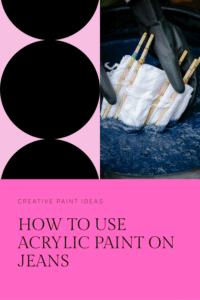Bathroom cabinets are often one of the first things you notice when you walk into a bathroom. Over time, they can become worn out and tired, with chips, stains, or peeling paint that can make your bathroom feel outdated.
But instead of replacing them, did you know that you can give them a fresh new look by painting them? Yes, that’s right!
A good paint job can make your bathroom cabinets look brand new at a fraction of the cost of a full remodel.
If you’ve been thinking about updating your bathroom, painting the cabinets is a simple and cost-effective way to give it an instant upgrade.
However, many people shy away from painting cabinets because they think it’s too complicated or time-consuming.
In reality, with the right materials, a little patience, and the step-by-step process I’m about to share, you’ll be able to transform your bathroom in no time.
In this article, I’m going to walk you through everything you need to know about painting bathroom cabinets, from preparation to the final coat of paint.
I’ll also share some personal tips and insights based on my own experience with painting cabinets, so you can avoid common mistakes and get the best results.
Why Paint Your Bathroom Cabinets?
Before we dive into the step-by-step guide, let’s talk about why painting your bathroom cabinets is such a smart decision. A simple coat of paint can:
- Refresh the Look: Over time, bathroom cabinets can become stained, chipped, or faded, especially in high-moisture areas like bathrooms. A new coat of paint can breathe new life into them and make your bathroom feel brand new.
- Save Money: Replacing bathroom cabinets can be expensive, and if your current cabinets are still in good condition structurally, painting them can save you hundreds, if not thousands, of dollars.
- Boost Home Value: If you’re planning to sell your home soon, updating your bathroom cabinets can increase your home’s appeal to potential buyers, adding value without breaking the bank.
- Personalize Your Space: Painting your cabinets gives you the opportunity to choose a color and finish that matches your style and the overall vibe of your bathroom.
Now that you know why painting your cabinets is such a great option, let’s get into how you can do it yourself!
Step-by-Step Guide to Painting Bathroom Cabinets
Painting bathroom cabinets isn’t as difficult as it may seem, but it does require some preparation and the right tools to ensure the finish is smooth and long-lasting. Here’s how to tackle the project:
1. Gather the Right Tools and Materials
Before you start, you’ll need to gather all the materials to make sure you’re prepared. Here’s a checklist of everything you’ll need for the job:
Essential Materials:
- Screwdriver (for removing cabinet doors and hardware)
- Painter’s tape
- Drop cloths or plastic sheets (to protect your bathroom surfaces)
- Cleaning supplies (soap, water, rags)
- Sandpaper (medium and fine grit)
- Primer (make sure it’s suitable for wood or laminate surfaces)
- Paint (high-quality latex or enamel paint for cabinets)
- Paintbrushes (2-3, with angled and flat bristles)
- Foam roller (for a smooth finish)
- Paint tray
- Clear polyurethane (optional, for extra durability)
2. Prepare the Cabinets
The preparation phase is critical to achieving a professional-looking finish. If you skip this step, you may end up with a bumpy or uneven finish that won’t last long.
- Remove Doors and Hardware: Start by unscrewing all cabinet doors and hardware (like handles or knobs). This will make it easier to paint all the surfaces and avoid any paint on your hardware.
- Clean Thoroughly: Use a mild soap and water solution to wipe down your cabinets. Bathrooms can accumulate grime and soap scum over time, so cleaning the surfaces is essential to ensure the paint adheres properly. Let the cabinets dry completely before moving on.
- Sand the Surfaces: Sanding the cabinets is crucial for a smooth and even finish. Use medium-grit sandpaper to scuff up the surface and remove any glossy finishes. This will help the primer and paint stick better. Once you’ve sanded everything down, switch to fine-grit sandpaper to smooth out the surface. Make sure to wipe off the dust with a clean cloth afterward.
- Apply Painter’s Tape: Tape off areas you don’t want to paint, like the edges of the wall, countertops, or floor. This will help ensure sharp, clean lines when you’re painting.
3. Prime the Cabinets
Priming is an important step when painting bathroom cabinets, especially if you’re painting over a dark color or a surface that hasn’t been painted before. Primer creates a bonding layer that helps the paint adhere better and ensures a more even coat.
- Apply the Primer: Use a good quality primer that’s suitable for wood or laminate surfaces. Apply a thin, even coat with your paintbrush or roller, making sure to get into all the nooks and crannies. Allow the primer to dry completely before moving on to the next step (usually 1-2 hours).
- Sand the Primer: Once the primer is dry, lightly sand the surface with fine-grit sandpaper. This helps to smooth out any imperfections and ensures that the paint will go on evenly. Wipe away the dust before painting.
4. Apply the Paint
Now comes the fun part applying the paint!
- Use a High-Quality Paint: For bathroom cabinets, I recommend using a high-quality latex or enamel paint. Latex paint dries faster and is easy to clean, while enamel paint provides a durable, smooth finish that’s perfect for high-moisture areas like bathrooms.
- Brush or Roll the Paint: I prefer to use a combination of a paintbrush and a foam roller. The brush helps get into the edges and corners, while the roller gives a smooth, streak-free finish on the flat surfaces. Apply thin, even coats, and allow each coat to dry fully before applying the next. Two coats of paint are usually sufficient, but you may need a third if the color change is drastic.
- Be Patient: I know it’s tempting to rush the process, but patience is key when painting cabinets. Let the paint dry completely between coats to avoid smudging or uneven coverage.
5. Finishing Touches
Once the final coat of paint has dried, it’s time to reassemble your cabinets.
- Reattach the Hardware and Doors: Once everything is dry and fully cured, carefully reattach the hardware and doors to your cabinets. I like to wait a few days before putting everything back in place to ensure the paint is fully set.
- Apply a Clear Top Coat (Optional): If you want extra durability, especially for cabinets that get a lot of use, consider applying a clear polyurethane top coat. This will protect the paint from wear and tear and keep your cabinets looking fresh for longer.
Table: Key Considerations When Choosing Paint for Bathroom Cabinets
| Consideration | Option 1: Latex Paint | Option 2: Enamel Paint |
| Drying Time | Fast-drying (1-2 hours between coats) | Slower drying (2-4 hours between coats) |
| Durability | Suitable for light to moderate use | Highly durable, ideal for high traffic |
| Finish Options | Matte, satin, or semi-gloss | Glossy finish for sleek look |
Common Mistakes to Avoid When Painting Bathroom Cabinets
While painting bathroom cabinets is a relatively easy DIY project, there are a few common mistakes you’ll want to avoid:
- Skipping Proper Preparation: It might be tempting to skip the cleaning or sanding, but this is one of the most important steps. Properly preparing your cabinets will ensure the paint adheres better and lasts longer.
- Using the Wrong Paint: Not all paints are suitable for bathroom cabinets. Make sure to choose a paint that’s resistant to moisture and mildew.
- Applying Paint Too Thick: Applying thick coats of paint may seem like a good idea, but it can lead to drips, streaks, and an uneven finish. Thin coats are key for a professional result.
- Not Letting the Paint Dry Enough Between Coats: Rushing the drying process can ruin your work. Allow each coat to dry fully before applying the next.
Conclusion: Transform Your Bathroom with Freshly Painted Cabinets
Updating your bathroom with a fresh coat of paint on your cabinets is a rewarding project that can completely change the look and feel of the space. With the right preparation, tools, and a bit of patience, you can achieve a professional-looking finish without the need for expensive renovations.
To sum it up, here are the key takeaways:
- Properly prepare your cabinets by cleaning, sanding, and priming.
- Use high-quality paint and apply thin, even coats.
- Be patient and allow each coat to dry before moving on to the next step.
- Consider applying a top coat for extra protection and durability.
Now, it’s time to put your knowledge to the test! Have you ever painted your bathroom cabinets before? Or are you planning to take on this project soon?
I’d love to hear about your experience or any tips you might have. Drop a comment below or share this guide with someone who’s ready to give their bathroom a makeover!
Frequently Asked Questions (FAQs)
Q: How long does it take to paint bathroom cabinets?
A: On average, it will take about 3-4 days to paint bathroom cabinets, factoring in drying times for each coat of primer and paint. If you’re in a hurry, you can speed things up by using a fan to help dry the paint.
Q: Can I paint laminate bathroom cabinets?
A: Yes! Laminate cabinets can be painted, but they require extra preparation. Make sure to sand the surface and apply a bonding primer before painting to ensure the paint sticks.
Q: Do I need to sand between each coat of paint?
A: Lightly sanding between coats can help achieve a smoother finish, but it’s not always necessary. It depends on the paint you’re using and the texture of your cabinets. If you do sand, make sure to wipe away all dust before applying the next coat.
Q: Can I use spray paint for bathroom cabinets?
A: While spray paint can work for small projects, it’s not ideal for bathroom cabinets. It’s harder to get even coverage, and it’s more difficult to control the flow of paint, especially on larger surfaces.



